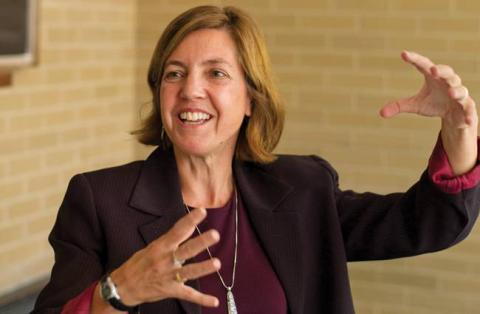
Conversation - A Healthy Collaboration
For this Conversation, Professor Colleen Grogan sat down with James Galloway, the assistant U.S. surgeon general, to talk about how public health is changing, the role of community organizations in public health, and more.
VOLUME 19 | ISSUE 1 | WINTER 2012
Public health has traditionally focused on issues like preventing an outbreak of an infectious disease and ensuring clean water. Recently, the field has increasingly turned its attention to promoting healthier behavior to fight obesity and inactivity.
The Building a Healthier Chicago initiative, for example, is using a social ecological model to tackle the interpersonal, institutional, community, environmental, social and public policy factors that influence health. The program is a collaboration among the American Medical Association, the Chicago Department of Public Health, and the U.S. Department of Health and Human Services–Region V.
For this Conversation, Colleen Grogan, a professor at SSA, sat down with James Galloway, the assistant U.S. surgeon general, acting regional director and regional health administrator for HHS’s Region V, to talk about how Building a Healthier Chicago operates, how public health is changing, the role of community organizations in public health, and more.
Grogan is the co-author of Healthy Voice/Unhealthy Silence: Advocating for Poor Peoples’ Health, and her latest book, which will re-examine the government’s role in the U.S. health care system, will be released later this year. She is the co-director for SSA’s Center for Health Administration Studies and the faculty chair for the Graduate Program in Health Administration and Policy.
A rear admiral in the United States Public Health Service, Galloway is a board certified physician in internal medicine and cardiology. He was the senior cardiologist nationally for the Indian Health Service and the director of the National Native American CVD Prevention Program, and he is the author of Primary Care of Native American Patients: Diagnosis, Therapy and Epidemiology.

Grogan: We’ve talked in the past about Building a Healthier Chicago, and some of our SSA students are doing their field placements in your office downtown. So I’ve heard a little about the work. To me, the most exciting part of the project is the collaboration and real connection to the community. How’s that going?
Galloway: It’s going very well. We grew from a small group about four years ago. In that first meeting with about twenty stakeholders, we really focused on wellness in general: activity, improved nutrition, and blood pressure control and prevention. Since that time, we’ve grown, but we’re still trying to make sure that we touch where people live, work, play, pray and learn. And we’ve gotten some great guidance and support out of Washington with our First Lady’s “Let’s Move” initiative. I also think it’s important to point out that the Affordable Care Act [ACA] includes a powerful focus on wellness as a serious and integral component of Medicare, Medicaid and insurance, and that it supports coverage without co-pays for evidence-based prevention activities such as mammography, colonoscopy, cholesterol and blood pressure checks. We have enthusiastically incorporated Let’s Move, which really fits with our view that it’s the leaders of the township, the school board, the parents, or the child himself or herself who are at the heart of these changes. Working with the business sector has also been exciting to me, because I think the integration of business and public health is the way of the future in many ways.
Grogan: That’s interesting. Business has been developing and enacting all of these health and wellness programs, but are you thinking of business involvement in the community? Do you see it more involved with public health policy?
Galloway: All of the above. I think many multinational corporations clearly understand the benefits of worksite wellness, including the approximate three-to-one return on investment. Many small and middle-sized organizations and companies don’t have the resources, the time or energy, to be able to do this, or may not be aware of the benefits. So approximately 100 members of Building a Healthier Chicago have developed a worksite wellness committee that includes the Chicago Chamber of Commerce, the Midwest Business Group on Health, the American Heart Association, our academic partners and many others. This committee has developed a whole toolkit that offers no or low-cost interventions for small and middle-sized companies to start the same kind of worksite wellness programs at their sites.
And some of the multinationals have found that engaging the families of their employees for disease control, disease management and prevention options is also clearly beneficial. We’re taking it a step further and looking at the customer base. Look at the impact of Wal-Mart’s four dollar prescription across the nation, for instance, or the fruits and vegetables that are being sold now in drugstore chains like Walgreens in food deserts and in other areas. The impact there is potentially tremendous. There are many similar examples of corporate social responsibility initiatives within private enterprise.
If we can assist in these efforts so that there’s a benefit to the companies to engage their employees’ families in wellness, in addition to their customers, and then potentially even coordinate these efforts, in a broad sense, with developing accountable care organizations, [the health care model where providers are reimbursed by outcomes for a population, as compared to feefor- service], we could potentially recognize great impact. The development of the accountable care organizations, although not yet finalized, has a tremendous amount of promise.
Grogan: That makes a lot of sense to me because we have such a fragmented system. So it’s interesting to hear you talk about connecting the employers and the employees to the accountable care organizations, and then bring in the families, because exercise and diet are so much a part of the family culture. If we just focus on an employee, when they go home to a family or a neighborhood, the behaviors we’re suggesting may not have the impact we want.
In terms of the model of healthy living as a community-level initiative, Charles Payne at SSA is very involved with the process of developing the Woodlawn Children’s Promise Community. The project, as I understand it, focuses mostly on school improvement, but with an integrated approach, working with school-based clinics with very strong ties to the community, with the idea that learning in the school includes being healthy, awake and safe.
Galloway: That’s a great example of wellness integration. BHC is not directly engaged in the Woodlawn Children’s Promise Community, but we think that each of the 77 communities throughout Chicago has some very promising practices. As we get together and showcase those, we hope to incorporate them widely. We also have the opportunity to share lessons with sister organizations that have developed in a couple of other cities around the U.S. to try to take this collaboration to a new level. Some of the school health clinics you mentioned are doing some really intriguing things. For example, there is one group in Miami that’s opening the school clinic after hours as a community clinic with a focus on wellness and prevention.
Grogan: For community-based organizations that are not involved in health services, it is new to be thinking about health. But I think they see the impact of chronic disease even if they’re trying to do economic development in the community. They see that a family is suffering because of an illness—–days lost from work or it’s just really expensive. I think the problems have forced even non-health community-based organizations to realize they need to be a part of this broader collaborative. With Building Healthier Chicago, how have you been able to tap into some of those organizations?
Galloway: Well, we have developed numerous collaborations with these organizations through several levels. One is with the organizations of health in the communities we work in—–the hospitals, the clinics, the federally-qualified health centers [FQHC]. These organizations are often integrated pretty broadly throughout the community, although not always equitably. And there are a number of community organizations we work directly with. We have a physician advisory council made up of many of the clinical and public health leaders in Chicago as well as a CEO council that provides us with guidance and expertise from many leading companies in the open broadly to everyone who may be interested to come, spend some time and learn about what we were trying to do and to see how they could help.
Grogan: For me this all is interesting because I’ve been doing research for a book that touches on the history of the public health movement at the turn of the century. I look at what happened in the federal Public Health Service and local and state health departments, and examine how and why they grew over time.
Already by 1910 or 1920, major public health leaders are saying, ‘Now we have sanitation and we need to attend to that, and we know we need to build research institutions for advances in things like bacteriology. But we also need to focus on chronic disease.’ They knew even back then that cancer and heart disease were among the top five killers in 1920. Of course infant mortality was still high, and infectious disease was high, but even then, they were saying we really need to think about chronic disease and health behaviors, encouraging all the kinds of things you’re doing and talking about now.
Galloway: You may recall when Dr. Richard Carmona, our prior Surgeon General, was selected. It was right around 9/11. He was called in to testify in front of Congress about issues of health and safety related to weapons of mass destruction and all the various horrendous things that could happen by terrorists and others. He spent several hours testifying in Congress and masterfully answered all their questions about anthrax, bioterrorism and other major concerns. As he was leaving, he had a surrounding group of reporters who asked him which of these threats—–bioterrorism, terrorist attacks, dirty bombs, anthrax, etc. - which is the greatest threat facing our country? And he answered, “obesity.” That answer took many people aback, but that’s where we are.
I give great credit to the CDC related to the cultivation of awareness about the issues of obesity in our nation and globally. I happened to be in the room when they showed Dr. Carmona the maps showing the change in the levels of obesity across the U.S., year by year. It’s motivating to see this amazing change, just in the last two decades, as a remarkable wave across America.
